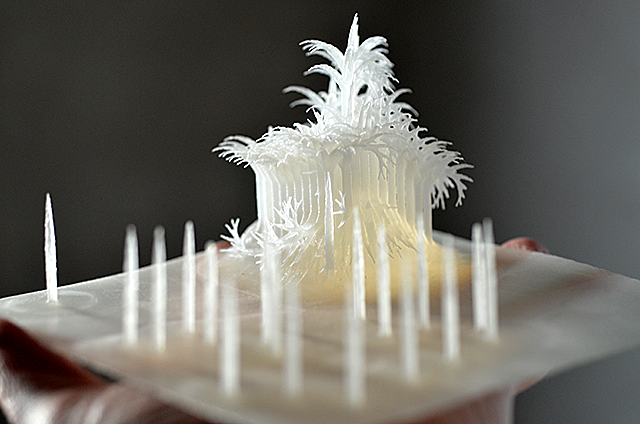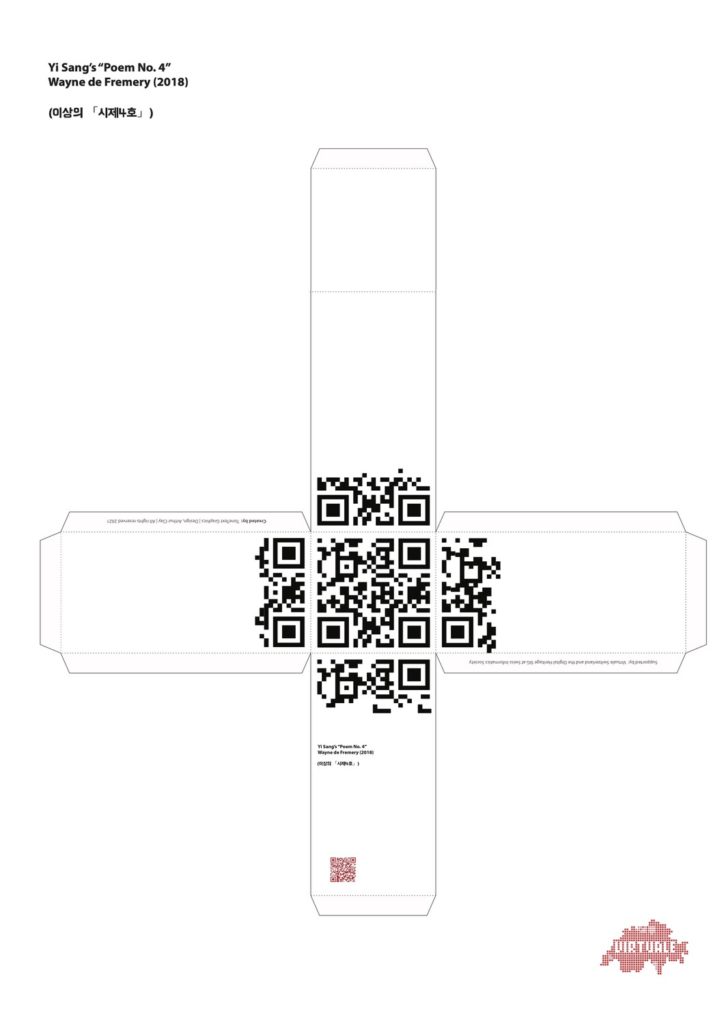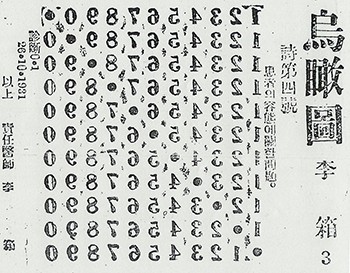
Three Poetry Sculptures by Wayne de Fremery based on canonical Korean poems
Introduction
In lieu of the certainty of holding an actual exhibition, art institutions as well as curators and artists have had to seek out new ways to get their work out into the public eye.
The exhibit “Technologies of Memory and Loss—An Armful of Azaleas”, here in the form of a mail art / pop up project, reproduces versions of the canonical Korean poems using data object in three dimensions and presents them virtually using AR technologies.
The project in this form consists of three models that project classic Korean poems onto three dimensional models created by mapping Unicode values extracted from the poem to re-articulate them as aesthetic objects that at the same time offer new ways to investigate the institutional systems of cultural memory we call literature.
 Fig. 1. the Pop Model of Yi Sang’s Poem No. 4
Fig. 1. the Pop Model of Yi Sang’s Poem No. 4
The Pop Up
The concept of the pop-up refers to something that explores a spatial niche temporary and thematically. The phrase “here today; gone tomorrow” describes the pop up in it common form. However, what is more important is the a pop up when presented in the form of mail-art is more like a tumble weed, because it comes and goes and the space in which manifests does not determines its identity.
In fact , the Pop Up versions of the exhibition “Technologies of Memory and Loss— An Armful of Azaleas” is a Mail-Art Project using Digital and Analog Strategies as a means for Cultural Mediation. Therefore, the project was created to be enjoyed in the confines of the home during a time where imposed physical constraints and along with the mental challenges must be overcome by using the imagination to engage ourselves in a form of aesthetic play.
Once opened, engagement begins and the “visitor” is on a path of discovery very much like the one when walking through an exhibition in a museum where one encounters artworks in a particular setting designed for it and with information, should one want it, really available to lear more.
The project is innovative not only because it makes use of new technologies but because it makes use of both digital and analog cultural strategies to create a project that can engage a wide and diverse audience through a variety of means and is able to make use of an establish network of communication from the post services to social media platforms.
 Fig. 2. Poem No. 4, Yi Sang
Fig. 2. Poem No. 4, Yi Sang
Home Gallery
There are three pop ups display stands that form the mail-art exhibition. Each of the pop ups can be cut out with scissors and taped or glued together.
Once ready, the pop ups are ready to interact with: The artworks can be seen by scanning in the QR code at the top of the display stand with any smart device. Once scanned in, the artwork appears floating above the QR Code. Like in an exhibition in real space, the visitor make their way around the stand to view the artwork from its different sides.
The name of the artist, the title of the work, and the date of its production are to be found on the sides of the display stand. In addition to these, there is a QR code that connect the visitor to a web app, which they can use to explore a range of information and graphics connected to the work in view.
Closing
Whatever creative strategies and alternative formats can be developed and applied so that art can prosper in a time where social distancing is the new norm, we must take into consideration that it may be just fine to shift shift away from intuitional event makers to smaller and more socially anchored ones.
Many great artists believed that there is always at least one person in audience who not only is receptive to what one is offering, but also is in the position to make a change in the artist life in a small or even large way.
_____
The project was supported by the Digital Arts & Technology and the Digital Heritage Groups at the Swiss informatics Society; Graphic design and interface work was done by ToneText under the guidance of Virtuale Switzerland.
Special thanks goes out to Augment, a simple but very useable app for creating AR.
_____
Wayne De Fremery is an associate professor at Sogang University in Seoul, in the School of Media, Arts, and Science. His research concerns bibliography and the socialisation of 20th-century Korean literary texts. Wayne holds a bachelor’s degree in Economics from Whitman College, a master’s degree in Korean Studies from Seoul National University, and a doctorate in East Asian Languages and Civilisations from Harvard University. Books and journals designed by Wayne have appeared with the Harvard Korea Institute, the University of Washington Press, and his own award-winning press Tamal Vista Publications. He holds three patents for inventions that creatively document and preserve culture and, in 2017, became a member of the Korean Agency for Technical Standards – the first non-Korean citizen to represent South Korea on an ISO committee.
Arthur Clay
is a producer and collaborator working between the borders of culture, sciences, and society. He has designed and implemented events focusing on creatively connecting science and technology within diverse cultural contexts in many parts of the world. As founder and artistic director of the ETH Digital Art Weeks his activities included developing, managing, and platforming projects that pioneer new technologies with institutes such as EPFL, ETH Zurich, University of the Arts Zurich, Xian Academy of the Arts, NTU and NUS of Singapore, Jiaotong University Shanghai, University of Victoria BC, Sogang University, Seoul National University, Singapore Polytechnic, Politecnico di Milano, and for various private and government agencies and institutions including Biocon Labs, SAST, A2Star, and more. Up to 2018, he co-organised the Seoul Bio Art Festival, an event platforming potentials between new technologies in the life sciences and the new arts exploring speculative design and wet media. At present he is managing director of Virtuale Switzerland, a new festival exploring new technologies for new needs in a world now transformed by digital lifestyles.